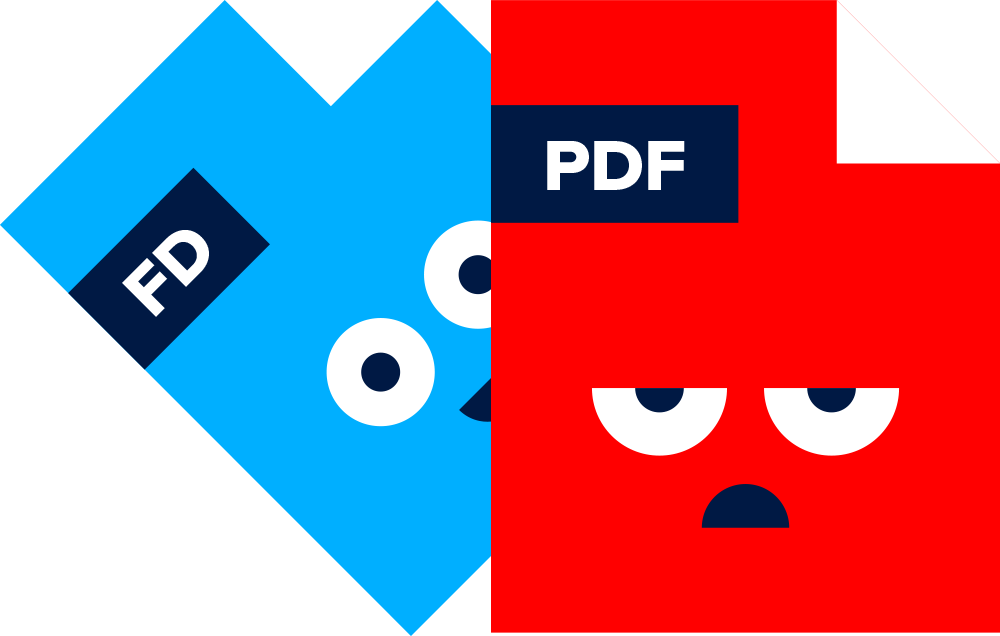Did you know that there's more than one type of PDF for your content?
I wouldn't be surprised if you didn't. Many of us are only familiar with the "classic" PDF used for online electricity bills, cover letters, and kitchen appliance manuals. However, you can choose from 6 types of PDFs that cater to different needs and use cases.
But what are their differentiating functionalities, and how do you know which one to use to achieve your content goals?
To get you up to speed, let me tell you what you may (or may not) have been missing out on in the world of PDFs.
A brief history of the PDF
Before diving into the nitty-gritty details of all the types of PDFs out there, let me give you my quick 30-second history lesson on the PDF.
Let's travel back to the early 1990s, the era of baggy mom jeans, OG Jurassic Park hype, and the birth of the PDF (Portable Document Format). Adobe introduced the file format, and it quickly became a game changer. Back in the day, sharing digital documents with other computer users wasn't easy or reliable, so a file format that anyone could open, regardless of their operating system, was revolutionary.
In short, PDF helped companies go paperless.
As the world became more technologically advanced, PDF tried to keep up with the times by adding new members to its family of formats, called PDF standards. However, content demand and competition quickly skyrocketed, pushing companies to rethink their technology and formats. New content creation tools started to appear, leaving the PDF a bit stuck in the past.
6 types of PDF standards
Like most of us, PDF has undergone some changes, and over the past 30 years, its family of file formats has grown, and new format standards have been added to cater to more businesses and use cases.
Here's what these different types of PDF standards can do.
The classic PDF file format displays text, fonts, images, and graphics using PostScript language. This format is the most known and used. In the 90s, PDF was a big problem-solver for content creators, but times have changed. Static, non-responsive, downloadable content just doesn't cut it anymore.
You can read more about content engagement here.
- PDF/A
For archives and records management
Portable Document Format Archivable file was developed for document archiving. That means a user of your file does not need to have the same fonts installed on their computer to read it. Pretty neat, eh?
The downside to archived PDF content is that it doesn't necessarily make for sexy reading. However, there are ways to make archived publications accessible, attractive, easy to navigate, and searchable.
- PDF/E
For engineering
PDF/E supports interactive media, such as animation and 3D images. This format was developed for architects and engineers to use in construction, manufacturing, and product design workflows.
Of course, there are many other ways you can turn your engaging, interactive content into an unforgettable content experience.
- PDF/X
For printing industry
Ideal for those working in print, PDF/X supports graphics in printing and sharing, ensuring high quality. This standard embeds graphic information like color profiles, fonts, and images in a certain way to forbid changes when printing.
Printing is probably the only industry where the static format works the best.
With paper supply chain issues throwing curveballs of late, the availability of paper stocks has become slimmer as costs rise and labor shortages continue.
Recent paper shortages can be seen as something positive for writers looking to create new content experiences for their audiences. Read Sim Samra's tips on how to make a stellar content experience.
- PDF/UA
For everyone
Universally accessible PDF documents were introduced in 2012 for users with disabilities that might require assistive technology when viewing documents.
We're beginning to see more companies prioritize the need for accessible content. Read more about that here.
- PDF/VT
For variable data printing
Due to its ability to maintain design elements like color profiles, layers, and customizable data, PDF/VT (Variable and Transactional) can be used for invoices, bank statements, and other documents for business purposes.
As more businesses move towards paperless offices, it's not a bad time to look for digital solutions. See how ACTIAM is doing it.
These six types of PDFs allow industries to use the file format best suited to them. Since not all PDFs have the same features and restrictions, it is essential to know which PDF to use and how to work with it.
Now, you might foresee a problem with that. For instance, if a department needs to use PDF/E for their tasks and projects, they need to ensure they have access to it, even if the rest of their company uses the classic PDF. This could create an internal disconnect between teams.
Should I only be considering PDFs for my content goals?
One main advantage of PDFs is that they show the same content and layout on every operating system, application, and device. Yes, on every device.
However, given that nearly 60% of global website traffic is generated by mobile devices (Statista, 2022), using a format that's not mobile responsive is a questionable choice.
Additionally, platform-independent layout and design make PDFs more challenging to edit. Who else has struggled to make changes to a PDF? I know I have.
The sad truth is that some of PDF's strongest selling points have turned against it as technology has changed and readers expect interactive content experiences.
Web publications are the moment
Why overcomplicate digital content creation? Instead of juggling between different types of PDFs, it might be worth looking into web publications instead.
They live online, are viewed with a web browser, and have a single-path navigation structure that guides your readers through the publication from beginning to end.
Web publications are usually created for specific use cases or campaigns, but get this: you don't need to choose between formats. You can customize the format to suit your needs. Using work templates makes B2B content creation quick and easy, and you can empower more people in your company to participate in the creation process, just like Avison Young did.
It's good to keep in mind that you always create content for your audience, so the reader experience is the place to start. Downloading a PDF that's static and difficult to read on mobile isn't the best reader experience. You don't want to lose their interest halfway through, right?
Speaking of reader engagement, web publications allow you to track your content's performance, giving you valuable insights into your readers' behavior, which pages they read, how long they spend on your publication, and when they lose interest.
The verdict is...
Various types of PDFs have been developed during its 30-year journey and created new standards for different industries and use cases. This is great, but as content creation has changed over the years, the need for scalable, interactive, and intelligent content has skyrocketed.
Unsurprisingly, companies favor formats that allow you to create content for any business use case and give the viewer an unforgettable experience, from newsletters to reports and white papers to sales proposals.
Let's give PDF and its family of formats some well-earned rest and put web publications to work, giving our audiences the content experiences they deserve.
.png?width=1600&name=Frame%2030%20(4).png)


